For a brand without a strong history in the trail market, Nike has created quite the buzz with their latest offerings: the Nike Zoom Terra Kiger and Nike Zoom Wildhorse. Both shoes have a lot of features that will appeal to a wide range of runners, and Nike has even gone so far as to create a brand new Trail Running Team (good info on the team here) that snatched up a lot of young, speedy trail runners to sport the new shoes in races all over the world.
Wildhorse vs. Terra Kiger
Before getting into a review of the Kiger, I wanted to point out some of the few minor differences between the Wildhorse and Kiger, since they are quite similar overall (same platform essentially).
The main differences as I see it from trying both on (I have not run in the Wildhorse) are in the design of the upper. The upper on the Wildhorse has a little more volume, doesn’t use the burrito wrap design, doesn’t have Flywire, and uses a different, more supportive mesh. The only change to the midsole from the Wildhorse is that the Kiger has a zoom unit (a piece of Nike technology that is inserted that uses air to cushion rather than EVA foam) in the forefoot and heel where as the Wildhorse only has one in the heel. Lastly, while sharing essentially the same outsole and midsole shape, the tread is slightly different on the two shoes. Normally I wouldn’t bring up so many features of a shoe I wasn’t actually reviewing, but in this case they are similar enough that I thought it was worth mentioning.
Now on to the Terra Kiger review…
Stats
Price: $125 MSRP
Colorways: I’ve seen 4 different colorways that are currently available: Blue/Citron, Grey/Volt, Blue/Volt, Green/Purple; the colorway of the pair shown that I’m reviewing is discontinued.
Weight: 8.3 oz/235 g in size 9 mens; 10.1 oz/285 g in my size 13 men’s; and 7.1 oz/200 g in size 8 for women (stats via Running Warehouse)
Stack Height: 23 mm Heel; 19 mm Forefoot stack height for both men and women (midsole heights of 10-14 mm are actually etched on the side of the shoe)
Appearance & Design
The Kiger is a very nice looking shoe, and looks fast while remaining fairly simple in design. Overall the design should appeal to a wide range of runners. It’s relatively light, well cushioned, and at 4mm drop still meets much of the market for this type of shoe. The design of the upper is great and definitely a highlight for me. It’s the first shoe where I felt the burrito wrap design actually worked.
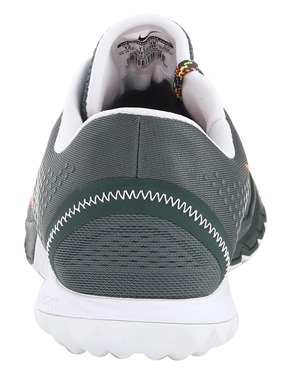 My biggest issue with the Kiger is in the sole design, particularly in the heel. The midsole shape in the heel is very fat for a racier shoe, and because the outsole curves up the side and back of the heel and doesn’t actually make contact with the ground, this adds instability and unnecessary weight to the shoe. As far as I can tell this design serves no purpose. The tread on the heel is also terrible with a shallow pyramid design that neither gives traction, nor stability of any kind.
My biggest issue with the Kiger is in the sole design, particularly in the heel. The midsole shape in the heel is very fat for a racier shoe, and because the outsole curves up the side and back of the heel and doesn’t actually make contact with the ground, this adds instability and unnecessary weight to the shoe. As far as I can tell this design serves no purpose. The tread on the heel is also terrible with a shallow pyramid design that neither gives traction, nor stability of any kind.
After two runs in the the shoe (and a few near ankle sprains), I took out the razor blade and grinding wheel and got to work (see comparison pictures below). After shaving all the excess outsole and thinning the width of the midsole, I can happily say the shoe runs much better. I put about 20 miles on the stock version and 30+ on the modified version and it almost feels like a different shoe on single track trail or uneven ground. Oh, and it dropped nearly 15 grams (0.5 oz) off the shoe which is not insignificant for a shoe in the 8 oz range.
Materials & Construction
This is where Nike really shines in my opinion. Likely because of their size and the breadth of products that they design and offer, Nike has a ton of fabulous materials to deploy on their shoes. They really show this off in the Kiger upper.
The upper material has a Flyknit-like pattern to it (to be clear it is not a Flyknit upper) that they call engineered mesh where the mesh has different weave densities in different locations. This material is awesome as it is super light and simple and, so far, has been very durable. I’ve taken them off-trail, through brush and other abrasive objects, and there is not a sign of wear on it. The interior of the upper is equally impressive with a full liner next to the foot and a super soft heel that does not have a heel counter. It is one of the softest uppers I’ve run in. I’ve run sock-less in this shoe for every mile even in 85+ deg F heat and no issues at all.
I’ll comment more on the midsole in the ride section, but the foam is high quality (I’ve seen conflicting pieces of info that it is full length Phylon and other places report that it is a dual density Cushlon ST in forefoot and Cushlon LT in heel…I have not been able to confirm one way or the other prior to review).
The outsole material is fine overall, if not a little too soft of a compound (the lugs are wearing pretty quick). The tread pattern, especially in the heel, is silly in my mind as it adds a lot of weight with no tangible benefit. I also don’t understand why they didn’t just have a complete full outsole without the line of exposed EVA separating the edges from the middle of the outsole. This creates a much softer edge for the shoe which decreases its precision and edging in more technical terrain. Complaints aside, the traction is adequate on dry surfaces. I have not run them in mud, but would expect them to be lacking due to the relatively shallow lug depth.
Fit
The fit is fantastic in comfort and average in security. It is a pretty low volume fit with a low toebox height and a more sock-like cut to the entire upper.
I’m mixed about the use of Flywire in the upper. While I haven’t had any major problems, the midfoot lockdown and lateral stability on the platform is not as good as what I’m used to with inov-8 or Merrell shoes. I’ve come to terms with this though and just don’t use the shoe on more technical terrain which requires a more secure fit (and a sharper midsole; more on that below). If the upper wasn’t as comfortable as it is, I’d be unhappy with the security of it; as it is, the fit is still very nice and comfortable for even long outings.
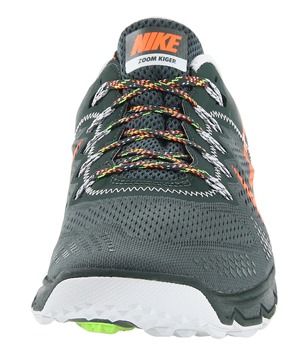 Ride
Ride
I found the Kiger hard to place regarding the ride. On one hand it does feel somewhat responsive and quick and on the other I felt it was somewhat soft compared to what I’m used to. Shaving the heel off did help the stability of the ride in the heel on uneven ground. I’d also say the softness is less noticeable on very hard pack trails, and is almost welcome on pavement. I guess this reaction is probably due to my experience with and bias towards firm and responsive shoes.
In its favor, the Kiger is the first shoe of any appreciable cushion and softness that I’ve actually grown to like for hardpack trails. It seems like every time I run in it I like it more than the run before, so part of it may be just needing to get used to the softer shoe.
Overall Impressions
Nike is off to a great start in the trail running market with the Zoom Terra Kiger. There is room for improvement with the heel shape/fatness, midfoot fit, outsole compound, and tread pattern (including upgrading to a full outsole). However, when taken as a whole the Kiger still gets more right than it gets wrong and I really can’t think of another trail shoe out there that offers the same fit and feel.
Regardless of your preference regarding cushion, I think there is something to be found here for everyone and that may be the Kiger’s biggest selling point. If you prefer more cushion, the Kiger will offer enough to feel comfortable and will likely feel fast and light for you. If you come from a minimalist/natural running perspective the Kiger still is a fairly light, low drop, and flexible shoe that will offer just a little more cushion than you might be used too (but, like me, you might grow to like it). As far as Nike trail running shoes go, this is as good as it gets. For any Nike Free fans looking for a trail option this would be the first shoe I would start with. I’m even considering given the Wildhorse a try to see how it compares on the run.
I’m going to give the Nike Terra Kiger a positive recommendation and look forward to future improvements.
Purchasing Options
The Nike Terra Kiger is available for purchase at Running Warehouse and Amazon.com, and outside the US it can be purchased at Wiggle or direct from Nike.com. Purchases made from these retailers help support this site – thanks!
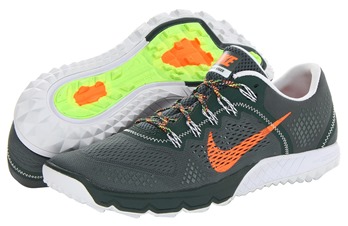
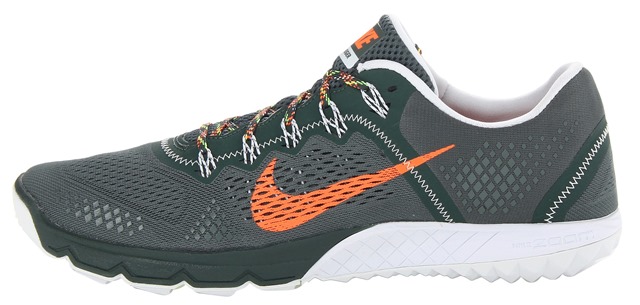

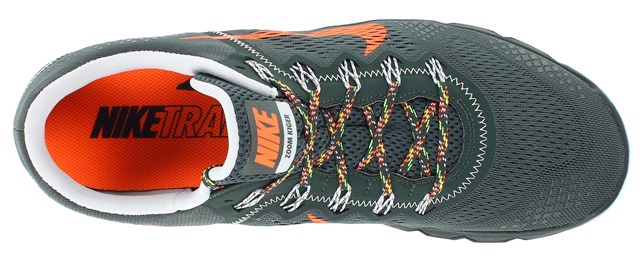

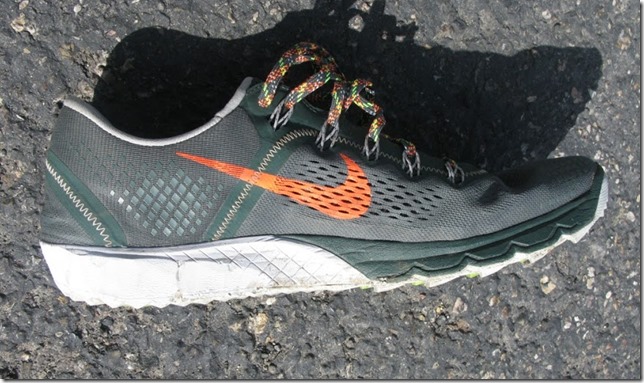

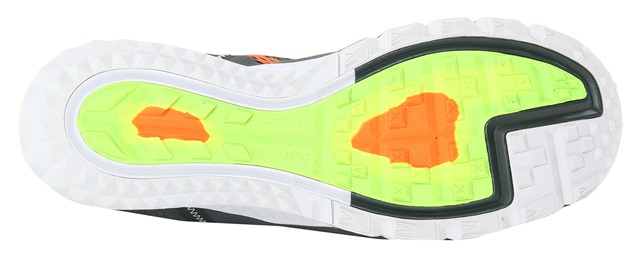
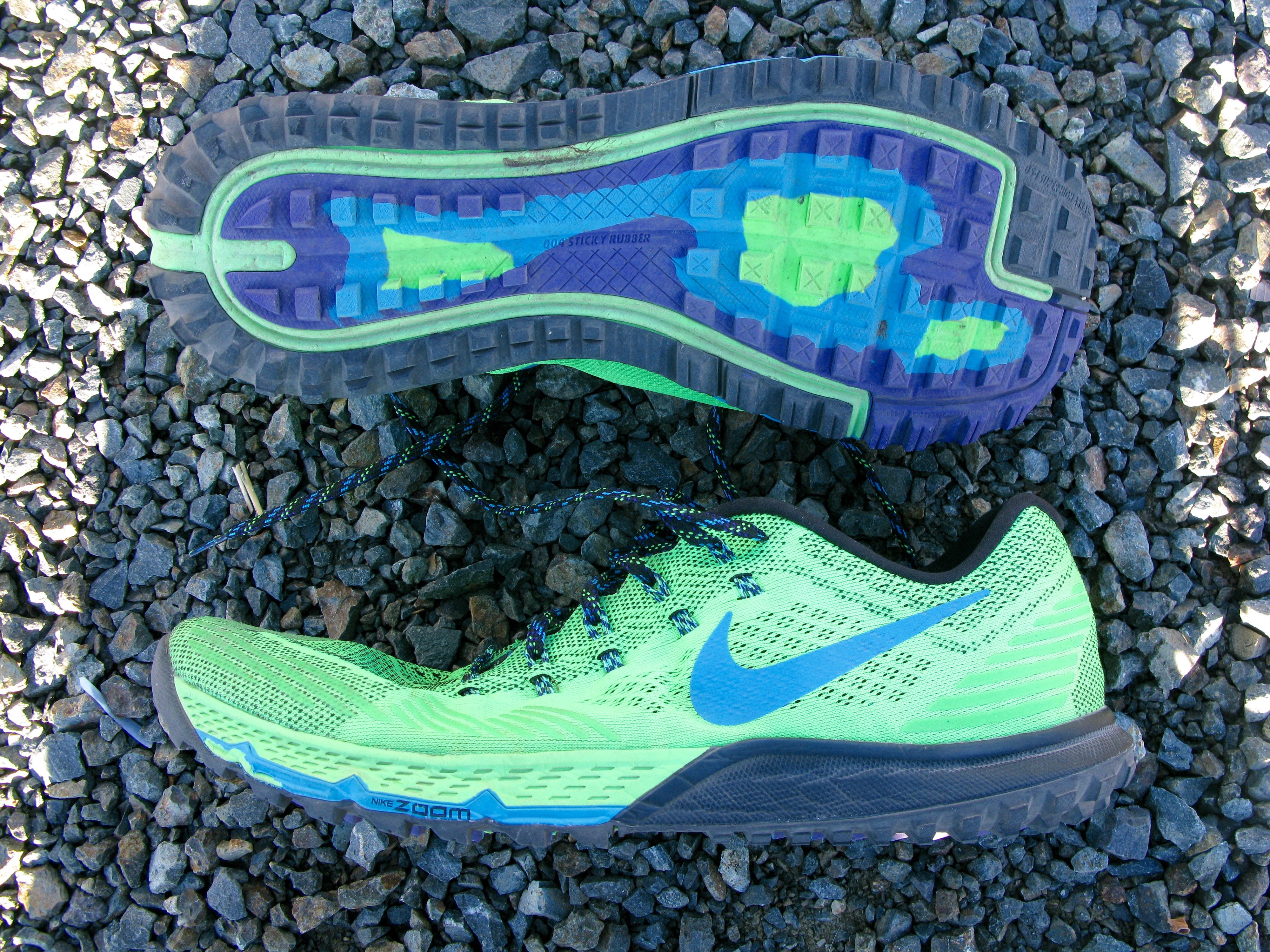


















How would you compare this to Brooks Pure Grit 2?I plan on buying a trial shoes and contemplating between them..and i prefer high volume and wider shoe..which would you think suits me..my right foot has developed a bunion (is it a right term?) on the outer edge
If you want high volume the Kiger might not be a good choice. I returned my pair due to a low volume forefoot. Width was fine, but top to bottom wasn’t enough space.
Glad to read I wasn’t the only one noticing the low toebox height. Disappointing since the rest of the shoe really nails it for me.
I agree with Pete on this one. Low volume forefoot (but plenty wide), which I happen to like, but for example I find the Puregrit to have too much volume in the midfoot for me and not enough forefoot width…funny how different people’s feet fit the same shoes so differently. You might give the Wildhorse a try Aron as it has more volume and would be more comparable to the Puregrit.
Thanks..both of you :)
Excellent review David. You picked out all the strengths and weaknesses of the Kiger design that I found.
The key weakness is the upper not secure enough for really technical stuff and heel lugs are very poor for grip and stability. The toe box is unnecessarily shallow and gives the big toe very little vertical space.
Like you I have grown surprisingly fond of the overly squiggly – initially I disliked it and found it unstable relative to my other shoes but it’s grown on me.
I now have the Wildhorse, it’s has a firmer forefoot than the Kiger which I prefer, and the upper is more secure and it’s only a little bit heavier. Alas it still has the flawed lug design at the heal.
Overall I quite like both shoes, make a good additional to my shoe rotation provide a bit more cushion than all my other shoes but retaining a low drop and reasonably light weight.
Thanks for the comment Robert and sounds like we both got a similar read on the shoe. I might try the Wildhorse as a firmer forefoot is more to my liking. I had figured the forefoot would be softer in the Wildhorse since it didn’t have the zoom unit in it, but sounds like I misjudged that.
Here is my test of the Wildhorse in addition and also a comparison video at the end. Both are great shoes and loving them. I am doing a super techy ultra in 37°C on Saturday and hoping to open up my stride in the ligers …
http://evolutionexpress.blogspot.fr/2014/05/nike-terra-zoom-wildhorse-personal.html
Thanks for the comment Levi. Nice comparison of the two shoes and I’m jealous of some of the races you mention. Ice Trail, Ronda del Cimms, UTMB, Kima Trophy, etc. are races that are very inspiring that I’d love to do someday. All the best.
A friend of mine loves these shoes and I really wanted to give them a try, but even going up a full size and a half, the forefoot was just too tight for my particular feet. I ended up with another shoe mentioned here a while back, the La Sportiva Helios.
I bought a pair awhile back as well and wound up returning them. Felt like my ankles were tilted in a bit, might be due to the curved heel that David cut off his pair. Also noticed the low volume toebox. Too bad as I really wanted to like the shoe! Might give another try when v2 comes out.
Matt, That is interesting that you ended up going with the Helios instead of the Kiger. I found the Helios, much too narrow in the forefoot for me and from a width perspective plenty wide for my average width foot, but sounds like it might have a volume issue more for you. You could try the Kiger with a lower volume insole or the Wildhorse, which has a higher volume fit with a similar platform. Thanks for the comment!
I find the Wildhorse and Kiger have quite height a similar above the toes. The Wildhorse has marginally more room, but the toe box is more rigid so there really isn’t much in it. Both have low volume in the forefoot compared to almost all my other shoes.
Judging from the photos of the grey model, it looks brethable only at the mid part, not at the forefoot where the fabric is more dense.
It is probably equally breathable in the forefoot, although I agree the photos don’t show it well. It is probably average on the scale of breathability, mainly because of the fact that it has a full interior liner. The payoff in comfort from the liner is worth it to me though.
I concur, I find both the Kiger and Wildhorse breathability is pretty consistent across the whole shoe, but alas but particular breathable overall.
Thanks to the liner is quite a warm shoe compared to the other shoes in my shoe rotation (such as the inov-8 F-Lite) so to keep my feet cool enough I find it best to run without socks with them. Running without socks also puts less pressure on the lack of height at the topbox. Thankfully the liner that makes less breathable also makes them very comfortable to wear sockless and is right up there with the Vivobarefoot shoes I’ve owned in terms of sock free comfort.
There are limits though, I did a hill run on trail that had been recently rained upon and this kick up lost of dirt onto my calves and down on my achilles. By the end of the run my Achilles on both feet had blisters as the damp dirty/sand had made it’s way into the heel collar and created a sandpaper effect. This isn’t a specific problem with the Kiger and Wildhorse, just with going sockless on wet and dirty trails.
My comments are based on my experience with the Wildhorse (333 miles and counting) and what it has in common with the Terra Kiger. I like and understand the rounded heel. It’s designed to provide stability in uneven ground and for contouring (sidehilling) as LeviD above mentions in his review. In those conditions, the edges do make contact with the ground. With the curve, initial ground contact will be less offset from the centerline of your foot/heel, so there is less moment twisting your foot. Contouring and running down a mountain yesterday, and it was very stable and I didn’t have to think about my feet. I have actually done the same heel foam carving surgery on a pair of Nike Frees several years back, but that was after 500 miles. I don’t think the Wildhorse or Kiger needs it, but if it make you happier with it, great.
I have no issues with the heel grip either, but it could be due to different running styles. Makes some at least some sense to have the best grip directly under the heel rather than to the sides, but the actual experience is more important than theory…
I sized up 1/2 a size in the Wildhorse, which gave me the proper length. With my wide feet, I found the volume too small, but the width sufficient, so I tried them on in the store with the insoles removed and decided that was fine – Saves more than 0.5 oz. too. :) That’s how I’ve run in them since, and it’s perfect.
The light outer mesh layer on my Wildhorse is shredding in places at the forefoot flex points and the medial side of the shoe, but the inner liner and supporting straps are in good shape, so it’s just cosmetic at this point. I wonder if the Terra Kiger’s upper is more durable.
I noticed squeaking after getting the shoes wet, such as after a creek crossing – sometimes in the left, sometime the right or both. I think it might be the Zoom Air unit moving relative to the midsole along with the water. Or maybe the Zoom units have popped and are sucking water in and out, though I believe the units are higher up on the midsole, and I don’t believe I punctured them. It’d be nice to have a version without the Zoom units to avoid the squeaking (if that is the cause).
Lightning Racer,
Thanks for your thought out reply. The roundedness of the heel was not particularly my issue more than the fact that the heel width was too wide (I noticed this mostly when off trail, which, to be fair, the shoe was not designed for). A round heel that is wide is probably better than a flat one that is wide, but a narrower heel is better than either of those options in my opinion (as long as the stack height of the heel is not too high that it becomes tippy) and the reality of the rounded heel is that, especially if one doesn’t heel strike much, you don’t ever really make ground contact with it, yet rubber and extra foam had to be used which just increase the weight and don’t add much functional value.
I didn’t have a major problem with the overall grip of the outsole, but the heel tread just has a lot of rubber with not a lot of edges on it, so again more weight without much function. I didn’t feel I needed more heel grip in this shoe per se, but I just felt the design of the outsole, particularly in the heel, was not what I would design in a trail shoe if I had a blank slate…I tend to like a similar pattern over the whole outsole, so for example on the Kiger, I would just put the same lugs they have in the forefoot in the heel…no reason to change them specifically for the heel IMO.
Regarding the squeaking, I also think it is unlikely the zoom air unit popped as they do sit (recessed) above the midsole like you mentioned. I think it is likely just your foot moving against the very rubbery bottom of the footbed (since you removed the liner). Just a guess though. Thanks for the comment and I will add that I do think the Kiger upper is more durable than the Wildhorse…haven’t run the WIldhorse myself, but it is the only one I’ve heard/seen pictures of the mesh coming apart on yet (not to say the Kiger won’t at some point, but they look flawless after 70 miles or so of rough running). All the best,
David
I live in the french Alpes and these shoes are insufficient for running here. They are runners with a more agressive tread pattern for loose and soft surfaces. They do not offer enough protection on rocky uneven trail: no rockplate, insufficient overlays against trail debris and a lack of rigidity and protection at the heel. Also the outsole is way too soft, i’ve already stripped down the outer forefoot lugs at 100k. Although the softness makes the shoe very supple with very good fit and foot hold, it also makes the ride squishy, unresponsive and flat with too much give resulting in foot movement when things start getting technical. Overall adequate for the “city trail” if you like but far from being a purpose trail shoe.
Andy,
I would agree with your assessment on the Kiger; not a good mountain running shoe at all. For mountain running I think they would need to be firmer, lower stack height (by 3-4mm or so), preferably a rock plate and a full rubber outsole with better lugs. I don’t take this shoe on anything technical which I save for inov-8s (mainly Trailroc 245, X-talon 212, and Mudclaw 265 for when I need good sticky rubber for scrambling and peak bagging). Hopefully we will see something from Nike that is more robust for technical terrain as the Kiger and Wildhorse are good first offerings from them. I’m getting in the Kiger 2 today and hopefully the Wildhorse 2 soon. It looks like they addresses some of the upper issues with the Kiger and reportedly the midsole is firmer which should add some protection. The outsole, unfortunately is unchanged, but it is what it is. Take care and enjoy the Alps…I’m hoping to get over there, particularly for UTMB one of these years.
-David